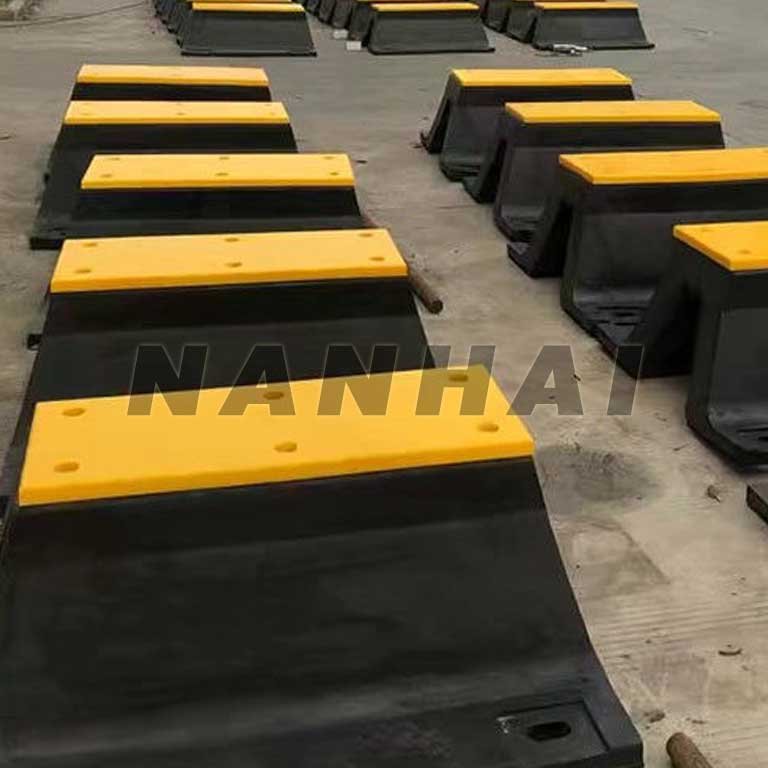When Are Hydropneumatic Fenders Necessary?
08/13/2025What Is a Salvage Operation on a Ship?
08/14/2025What is the function of UHMW-PE sheet on rubber fenders?
If you’ve seen a big ship coming alongside a dock, you’ve probably noticed those chunky rubber fenders hanging on the quay. They’re the silent heroes that take the impact, keeping both the dock and the vessel safe.
But sometimes, you’ll see something extra on the front of those fenders — a smooth, colorful plastic sheet. That’s UHMW-PE, short for Ultra-High Molecular Weight Polyethylene. Sounds like a mouthful, but it’s basically a super-tough, low-friction plastic that makes berthing smoother and safer.
Let’s break down why it’s there, what it does, and why ports and shipyards swear by it.
What Is UHMW-PE and Why Add It to Rubber Fenders?
Rubber fenders are great at absorbing energy when a ship comes into berth. They compress and bounce back, taking the force so the hull doesn’t.
UHMW-PE doesn’t replace that function — it adds another layer of protection. Think of it like a smooth shield in front of your fender. It’s:
- Extremely tough — handles heavy impacts without breaking.
- Super slippery — ships can slide along without grabbing or jerking.
- Resistant to the elements — saltwater, UV light, chemicals… it shrugs them off.
When paired with a steel fender panel, UHMW-PE extends the life of the entire fender system and enhances its performance.

The Main Functions of UHMW-PE Sheets on Rubber Fenders
1. Low Friction for Smooth Berthing
Ships don’t always come in perfectly straight. UHMW-PE lets the hull glide across the fender face instead of sticking. That means less stress on the rubber fenders, the panel, and the hull.
2. Protects the Fender and the Ship’s Paint
It acts like a sacrificial layer. The UHMW-PE takes the scuffs and scratches, not the expensive fender panel or the ship’s paint job.
3. Spreads the Load
The sheet helps spread the force evenly across the panel. No small “hot spots” that could damage the hull or dent the fender face.
4. Handles Harsh Marine Conditions
Rain, waves, UV light — none of these bother UHMW-PE. It doesn’t rust or rot, and it stays strong even in extreme cold or heat.
5. Quieter Operations
Steel-on-steel or rubber-on-hull contact can be noisy. UHMW-PE dampens that noise, making berthing a lot more pleasant for crew and port workers.
When Should You Use UHMW-PE with Rubber Fenders?
UHMW-PE isn’t needed on every fender, but it’s a smart choice when:
- Large ships or tankers berth often.
- Vessels have delicate or freshly painted hulls.
- The berth sees a lot of angled approaches.
- The environment is abrasive (sandy water, debris).
- The port operates in very cold or icy conditions.
How to Choose the Right UHMW-PE for Your Fender
Not all UHMW-PE sheets are the same. Here’s what to look for:
- Grade: Virgin material lasts longer; UV-stabilized grades resist sunlight.
- Thickness: Thicker sheets handle more wear.
- Surface finish: Smooth for general use; textured for extra grip.
- Color: Black, green, blue, or custom — some ports use colors for visibility.
- Mounting: Use countersunk bolts so nothing sticks out to scratch the hull.
- Thermal expansion: Leave room for it to expand in the heat.
Installing UHMW-PE on Rubber Fenders
The UHMW-PE is usually bolted onto a steel fender panel, which is mounted in front of the rubber fenders. A good installation will:
- Have bolts flush with the surface.
- Be aligned with the waterline for the ship types using the berth.
- Allow for movement when temperatures change.
- Pass a final sliding test before the berth is put into service.
Maintaining UHMW-PE Facings
UHMW-PE needs little care, but it’s not “fit and forget.” Ports should:
- Check for wear after heavy impacts.
- Replace worn pads before they get too thin.
- Clean off grit or barnacles to keep friction low.
- Tighten bolts if needed.
The good news? You can often replace just the UHMW-PE pads without removing the entire rubber fender.
Common Mistakes to Avoid
- Mounting UHMW-PE directly to the rubber fender without a panel.
- Using too thin a sheet for heavy-duty berths.
- Forgetting to allow for expansion in hot weather.
- Leaving bolt heads exposed.
- Skipping regular inspections.
FAQ
Do rubber fenders need UHMW-PE sheets?
Not always, but they’re highly recommended for frequent or angled berthings, or when protecting valuable hull coatings.
Does UHMW-PE change the energy absorption of the fender?
No — the rubber fenders still absorb the energy. The UHMW-PE just helps manage the contact surface.
How thick should it be?
It depends on your vessel sizes, traffic, and environment. Heavy-duty berths may use 30–50 mm thick sheets.
Will UHMW-PE scratch hull paint?
It’s designed to reduce the risk, but keep it clean so grit doesn’t get embedded.
Final Thoughts
UHMW-PE sheets may not look like much, but they make a big difference in how rubber fenders perform. They protect the hull, reduce wear on the fender, and keep berthing smooth and safe.
If your port deals with large ships, frequent traffic, or challenging conditions, pairing rubber fenders with UHMW-PE facing could save you a lot of time, money, and headaches.
